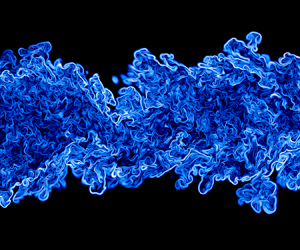Article contents
New symmetry-induced scaling laws of passive scalar transport in turbulent plane jets
Published online by Cambridge University Press: 20 May 2021
Abstract

The primary object of this study is to derive new scaling laws for passive scalar statistical quantities in temporally and spatially evolving plane turbulent jet flows. We apply Lie symmetry analysis to the equations governing the evolution of the first three statistical moments for the passive scalar quantities. The analysis is based on novel forms of the two-point velocity–scalar and scalar–scalar correlation equations, which are naturally based on the statistical moments derived from the instantaneous velocities and not on those of the fluctuation velocities from the Reynolds decomposition. The newly derived invariant solutions recover the gaps in the classical self-similarity analysis from three major perspectives. First, the scaling laws are constructed as the direct consequence of the symmetry approach, while an a priori set of similarity scales is not required. Second, unlike in the classical laws, which show self-similarity primarily for the first moments, here self-similarity is theoretically shown up to the third moments. Third, there is a symmetry breaking induced by the integral invariant of the mean temperature that connects the scaling symmetries of momentum and passive scalar equations, which results in a close coupling of the scaling exponents of the first two moments and, further, determines the scaling exponents of all higher moments. To verify the new theoretical findings, we employ data from two direct numerical simulations of the mixing of a passive scalar driven by a temporally evolving turbulent jet. The direct numerical simulation data very clearly validate the new scaling laws up to the third moments.
- Type
- JFM Papers
- Information
- Copyright
- © The Author(s), 2021. Published by Cambridge University Press
References
REFERENCES
- 5
- Cited by





